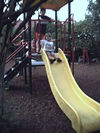|
The inclined plane
 An
inclined plane is a flat surface set at an angle. The mechanical advantage
of an inclined
plane is generally high so it is easier to lift or move heavy objects
by increasing the distance travelled. Chocking a wedge under a rock
with a sledge hammer will eventually move most stubborn boulders, by
applying a large force over a short distance. Decreasing the angle of
the plane increases the mechanical advantage, while also increasing
the distance the object has to travel. The same amount of work is done,
but it makes what could be a difficult task easier. An
inclined plane is a flat surface set at an angle. The mechanical advantage
of an inclined
plane is generally high so it is easier to lift or move heavy objects
by increasing the distance travelled. Chocking a wedge under a rock
with a sledge hammer will eventually move most stubborn boulders, by
applying a large force over a short distance. Decreasing the angle of
the plane increases the mechanical advantage, while also increasing
the distance the object has to travel. The same amount of work is done,
but it makes what could be a difficult task easier.
The inclined plane
as a ramp
 Inclined planes, commonly called ramps, are seen at the entrances
to buildings, where a driveway crosses a footpath or as a pathway up
a steep slope. Ramps are easier to walk up than steps, and the gentle
continuous slope provides easier access for wheelchairs and prams. It's
also easier to load heavy objects into a truck for example by leaning
a plank from the ground to the back of the truck.
Inclined planes, commonly called ramps, are seen at the entrances
to buildings, where a driveway crosses a footpath or as a pathway up
a steep slope. Ramps are easier to walk up than steps, and the gentle
continuous slope provides easier access for wheelchairs and prams. It's
also easier to load heavy objects into a truck for example by leaning
a plank from the ground to the back of the truck.
A child's slide is an inclined plane
too
 In a child's slide the force is controlled in a different way to
the plank leaning against the back of a truck. If the child fell from
the top of the slide then the force on landing could cause injury. By
increasing the distance the child travels, the force is reduced.
In a child's slide the force is controlled in a different way to
the plank leaning against the back of a truck. If the child fell from
the top of the slide then the force on landing could cause injury. By
increasing the distance the child travels, the force is reduced.
Effort versus load
Look at this ramp.
 Pushing the load up the ramp means that it moves along a distance
that is double the vertical height. The payoff is that the effort required
is only half that needed to lift the load vertically the same distance.
Pushing the load up the ramp means that it moves along a distance
that is double the vertical height. The payoff is that the effort required
is only half that needed to lift the load vertically the same distance.
The general rule is that a less steep slope means that the object moves
further, but the effort is less. The ratio of vertical height to slope
distance is equal to the proportional effort needed.
If, in the illustration above, the slope is reduced so
that the slope distance is 3 metres, then the effort required is one
third of that needed to raise the object vertically.
|